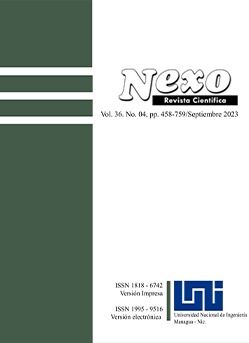Construction systems, integrated disaster risk management & climate change adaptation - Tiktik Kaanu indigenous community
DOI:
https://doi.org/10.5377/nexo.v36i04.16749Keywords:
vulnerability, households, management community, humid tropicsAbstract
The Caribbean Coast of Nicaragua is a pluricultural and multilingual region where diverse cultures coexist: Miskito, Sumu-Mayangna and Rama indigenous peoples, Afro-descendant Kriol and Garifuna communities and mestizo communities. This makes the Caribbean one of the richest areas in terms of cultural diversity and identity. It is a fact that the acceleration of climate change variability is a global problem that affects everyone, but differently and that its effects are evident in Nicaragua and mainly in the Caribbean Coast and these will begin to impact many aspects of life. The native peoples and ethnic communities of the region face particular vulnerabilities and risks in the face of the threats caused by climate change. The causes and consequences are understood in different ways, depending on the vision of nature that different cultures have, ranging from perceptions of changes in the environment to predict weather and climate fluctuations to highly described and orally documented variations in climate patterns. The ethnographic study in the Tiktik Kaanu community, Bluefields Municipality, South Coast Autonomous Region, Republic of Nicaragua, aims to describe the ethnicity, culture and construction systems in disaster risk conditions in the community of Tiktik Kaanu, located 42 kilometers south of Bluefields on the banks of the Kukra River, as part of the research and extension sections of the referred subproject.
Downloads
1242
Downloads
Published
How to Cite
Issue
Section
License
Copyright (c) 2023 Universidad Nacional de Ingeniería

This work is licensed under a Creative Commons Attribution 4.0 International License.
The authors who publish in Nexo Scientific Journal agree to the following terms:
- Authors retain the copyright and grant the journal the right of the first publication under the license Creative Commons Attribution License, which allows others to share the work with a recognition of the authorship of the work and the initial publication in Nexo Scientific Journal.
- Authors may separately establish additional agreements for the non-exclusive distribution of the version of the work published in the journal (for example, in an institutional repository or a book), with the recognition of the initial publication in Nexo Scientific Journal.
- Authors are allowed and encouraged to disseminate their works electronically (for example, in institutional repositories or in their own website) before and during the submission process, as it can lead to productive exchanges, as well as earlier and greater citation of published works.










